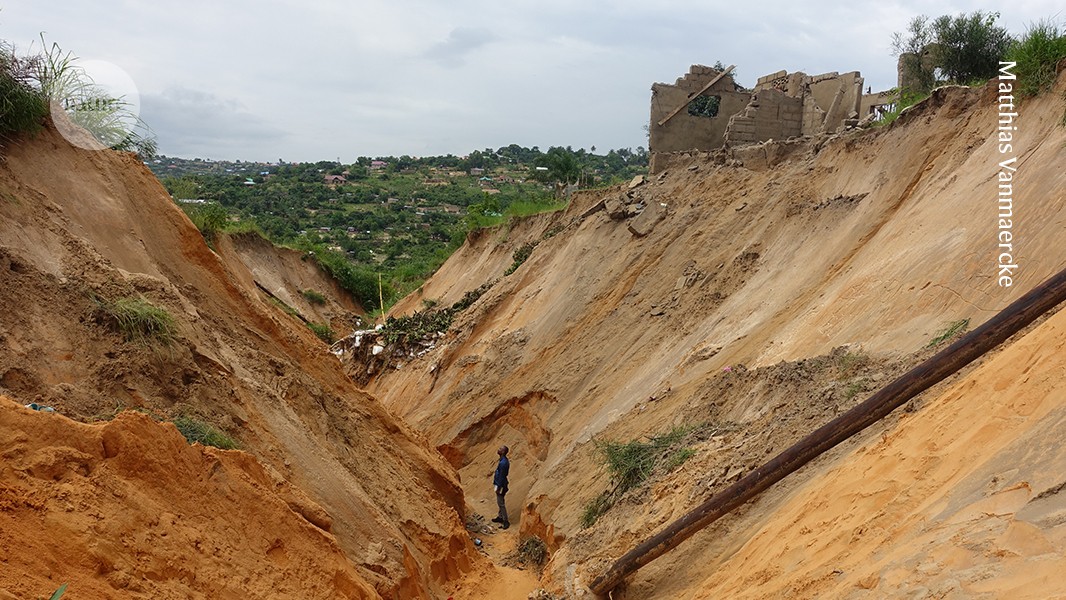Hazardous science that helps to save and improve lives needs more support

Research into the growing environmental problem of urban gullies highlights the challenging conditions under which many socially important studies are done

Urban gullies, such as this one in Kinshasa, Democratic Republic of the Congo, are a growing hazard.Credit: Matthias Vanmaercke
Scientific knowledge is produced mainly at a distance from the risks that researchers seek to understand, and from the people affected by the hazards. But in some parts of the world, researchers are not separated from those hazards: they work in unstable environments with limited resources and sometimes under life-threatening conditions. A study published in Nature this week1 offers a reminder of how high the stakes are when conducting this type of research, and highlights the urgent need to better support such work.
The subject of the study was urban gullies — deep, often rapidly expanding channels formed mainly by rainwater run-off in unstable, sandy soils. In most cities, many of which are in tropical regions, the formation of these gullies is increased when rainwater that accumulates in roads and on rooftops without suitable drainage systems is channelled onto unprotected soil. Once formed, these deep cuts in the ground stretch for hundreds of metres and, over time, tear through crowded cities, swallow houses and infrastructure and devastate lives and livelihoods.
The consequences of urban gullies have already been documented by studies in, for example, Nigeria2, Uganda3, the Republic of Congo4 and Brazil5. In the Nature study1, researchers based in Belgium, the Democratic Republic of the Congo (DRC) and Poland used a combination of satellite imaging and field research to produce a country-wide map of urban gullies across the DRC. They identified nearly 3,000 gullies, spread across 26 of the 47 cities they studied. Kinshasa — the DRC’s rapidly expanding capital, which has an estimated population of nearly 18 million people — is one of the most affected. There, the researchers identified 868 urban gullies with a combined length of 221 kilometres.
Their best estimate is that some 120,000 people have been displaced by urban gullies in the DRC between 2004 and 2023. Within the next 10 years, 28% of about 550,000 people living in the expected expansion zone of gullies are likely to be displaced if nothing is done.
Continuing damage
At least some of what needs to be done is clear. Gully formation and expansion can mostly be avoided with better urban planning and improved drainage systems. But in many fast-growing cities in the low- and middle-income countries most affected, urban-planning efforts are simply not keeping up. Once a gully has formed, stabilizing it to prevent further expansion comes with huge costs in places where financial resources are often limited, institutional mandates to deal with the problem are unclear and technical capacity is lacking. And so the damage continues.
The people who bear the brunt tend to be society’s poorest. It is often these individuals who resort to building homes and settling on unsafe lands. They might understand the risks they face, but they have no real choice but to live with them. People living on the edge of an expanding gully often find that they are unable to sell their land, leaving them trapped, with no other option but to seek shelter with relatives or friends on rainy nights, when there is a risk of further collapse.
This latest study is a reminder that high-quality, world-changing research often comes from working in difficult conditions with limited resources and far from high-tech laboratories. While the paper was under consideration at Nature, one of the study authors was in eastern DRC when renewed conflict broke out in the region. Electricity was down for many hours during the day and mobile-phone networks often failed — obstacles invisible in the final publication.
More broadly, the study is also a reminder of the responsibilities such research brings. While performing their fieldwork, the scientists were confronted with the stark consequences of gully formation for people on the ground. During a field trip to Kinshasa in 2019, the team met a mother whose family home stood near a gully edge. Two days later, several of her children were killed when a gully collapsed overnight near a relative’s house the family had sought shelter at. At least 40 people died that night.
Like many others, the family in Kinshasa expressed their hope to the team that research could lead to lasting solutions. Expectations should be tempered: science alone cannot solve these and similar problems. For communities living under immediate threats, the need to translate research into action is urgent. Finding solutions and acting on them must be seen not just as a priority, but also as a social responsibility — one that puts the needs of the affected communities first.
Research in challenging conditions should be better supported, funded and appreciated on its own terms. Institutions, funders and publishers must show heightened awareness of what such studies take to produce and the importance of publicizing the results. The ultimate purpose of science is not only to understand the world, but also to help make it safer. The whole research ecosystem must pull together to assist that aim.
Nature 644, 841 (2025)
doi: https://doi.org/10.1038/d41586-025-02684-7
This story originally appeared on: Nature - Author:furtherReadingSection

















